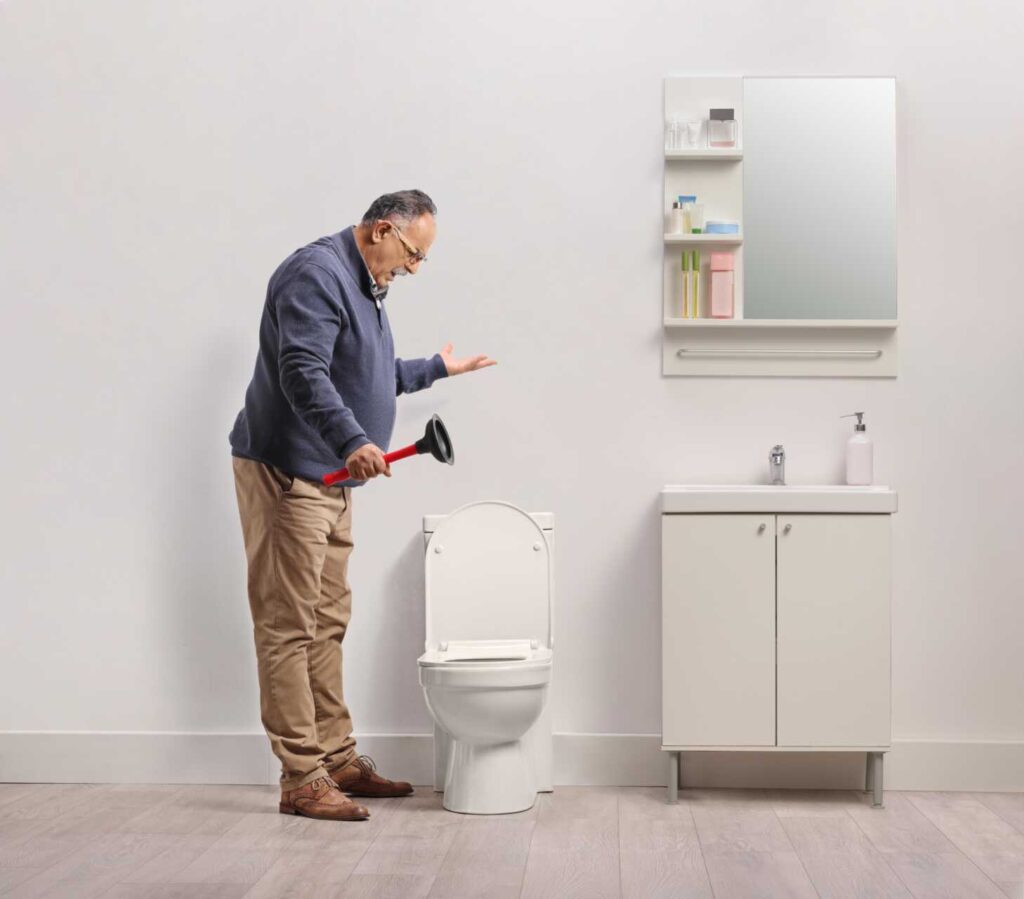
Contents
When a sewage backup occurs in your home, acting quickly is fundamental. You need to understand the causes and risks involved to effectively manage the situation. Safety precautions are essential during cleanup, as exposure to pathogens can pose serious health risks. Knowing what equipment and supplies to use can make the process more efficient. Let’s explore the key steps you must take to ensure a safe and thorough cleanup.
Key Takeaways
- Evacuate the area immediately and wear protective gear to prevent exposure to harmful pathogens during cleanup.
- Shut off water and power to the affected area to minimize hazards and prevent further contamination.
- Remove standing water with pumps or buckets and dispose of any damaged materials properly.
- Thoroughly disinfect all surfaces with industrial-strength products to eliminate bacteria and viruses after cleanup.
- Schedule regular plumbing inspections and educate your family on proper disposal methods to prevent future sewage backups.
Understanding Sewage Backup: Causes and Risks
When you experience a sewage backup, understanding its causes and risks is essential for effective response and prevention. Sewage systems can fail for various reasons, including clogged pipes, faulty design, or heavy rainfall overwhelming the system.
Grease, hair, and foreign objects often contribute to blockages, leading to backups that can threaten your home.
The risks associated with sewage backups are significant. Exposure to sewage can cause serious health issues, as it contains harmful bacteria and pathogens. Additionally, untreated sewage can damage your property, leading to costly repairs and extensive cleanup.
To minimize these risks, focus on backup prevention strategies. Regular maintenance of your sewage systems, such as routine inspections and cleaning, can help identify potential problems before they escalate.
Immediate Steps to Take After a Sewage Backup
After a sewage backup, your first priority should be safety.
Turn off electricity in affected areas and avoid contact with contaminated water.
Next, assess the extent of the damage to determine the necessary cleanup steps.
Prioritize Safety Measures
Since sewage backups pose significant health risks, it’s vital to act quickly and prioritize safety measures.
Following proper safety protocols protects you and fosters a sense of community well-being.
Here’s what you should do immediately:
Evacuate the area: Make sure that everyone leaves the affected space to avoid exposure to harmful pathogens.
Wear protective gear: Equip yourself with gloves, masks, and boots before attempting any cleanup. This promotes safety during your emergency preparedness efforts.
Turn off utilities: Shut off water and power to prevent further complications and hazards.
Assess Damage Extent
Once you’ve ensured everyone’s safety, it’s time to assess the extent of the damage caused by the sewage backup.
Begin your damage assessment by identifying the affected areas, including floors, walls, and furniture. Document the damage with photos for insurance purposes, and note any items that may need replacement.
Check for potential structural issues or mold growth, which can escalate if not addressed quickly. Conduct a thorough cleanup evaluation to determine what can be salvaged versus what needs disposal.
Make sure to wear protective gear during this assessment, as contaminants pose health risks. Understanding the damage will guide your next steps in the cleanup process, ensuring you tackle the situation effectively and safely.
Personal Safety Precautions During Cleanup
When cleaning up a sewage backup, it’s essential to wear appropriate protective gear, including gloves, masks, and waterproof boots.
These precautions minimize your exposure to harmful pathogens and chemicals present in sewage.
Additionally, following safe cleanup practices ensures your safety and the effectiveness of the cleanup process.
Protective Gear Requirements
To ensure your safety during sewage backup cleanup, it’s essential to wear appropriate protective gear.
Adhering to safety regulations is essential to minimize health risks.
Here’s a quick list of essential items you should have:
Gloves: Use heavy-duty, waterproof gloves to protect your hands from harmful pathogens.
Masks: A respirator mask is critical to prevent inhalation of airborne contaminants.
Boots: Waterproof, knee-high boots will shield your feet from exposure to contaminated water.
Safe Cleanup Practices
While you may be enthusiastic to start the cleanup process after a sewage backup, prioritizing safety is essential.
Begin by wearing the appropriate protective gear, including gloves, masks, and boots. This minimizes your exposure to harmful contaminants.
When handling contaminated materials, ensure you follow safe disposal practices—seal waste in plastic bags and dispose of it in compliance with local regulations.
Be aware of potential health risks, such as infections or respiratory issues, and take breaks to avoid fatigue.
Ventilate the area thoroughly to reduce airborne pathogens.
If the situation feels overwhelming, don’t hesitate to contact professionals.
Your safety and health are paramount, so never compromise on precautions during the cleanup process.
Essential Equipment and Supplies for Sewage Cleanup
Effective sewage cleanup requires a range of essential equipment and supplies to ensure safety and thoroughness. When you’re faced with a sewage backup, it’s vital to have the right tools at your disposal.
Here are three key items you’ll need:
Safety Equipment: This includes gloves, goggles, and masks to protect yourself from harmful pathogens and toxic fumes.
Cleanup Supplies: You’ll need heavy-duty trash bags, mops, and buckets for efficient waste removal and sanitation.
Disinfectants: Use industrial-strength disinfectants to kill bacteria and viruses, ensuring a safe environment post-cleanup.
Having these items ready helps you tackle the situation effectively and fosters a sense of belonging as you take control of your home’s safety.
Equip yourself well, and you’ll navigate the cleanup process with confidence and care.
The Cleanup Process: Step-by-Step Guide
Cleaning up after a sewage backup requires a systematic approach to ensure safety and effectiveness.
First, make sure you’re wearing protective gear, including gloves and masks. Next, shut off the water supply to prevent further contamination. Use effective cleanup techniques to remove standing water, employing pumps if necessary.
Afterward, start removing damaged materials, like carpets or drywall, to facilitate thorough drying. Once the area is clear, begin drying surfaces using fans and dehumidifiers.
Implement recovery strategies by addressing the underlying issues that caused the backup. Inspect plumbing and drains to prevent future occurrences. Throughout the process, maintain proper ventilation to disperse any harmful odors.
Lastly, document the damage for insurance purposes before moving on to the next stage of disinfecting and sanitizing affected areas. Following these steps will make certain you tackle the cleanup efficiently, promoting a safe living environment for you and your family.
Disinfecting and Sanitizing Affected Areas
Once you’ve removed damaged materials and dried the affected areas, it’s crucial to disinfect and sanitize surfaces to eliminate harmful pathogens. This step ensures your home remains safe for you and your family.
Here are three effective approaches to take into account:
Use EPA-Approved Disinfection Methods: Opt for products that meet EPA standards for efficacy against sewage-related pathogens. Always follow the manufacturer’s instructions for dilution and contact time.
Select the Right Sanitization Products: Choose sanitizers that can effectively reduce microbial contamination. Look for quaternary ammonium compounds or hydrogen peroxide-based cleaners.
Apply Thoroughly: Don’t forget to cover all surfaces, including floors, walls, and any items that came into contact with contaminated water. Ensure proper ventilation to aid in drying and improve the effectiveness of the products.
Assessing and Repairing Water Damage
As you begin the recovery process, evaluating and repairing water damage is vital to restore your home’s safety and integrity. First, identify the affected areas, noting any visible signs of damage such as discoloration or mold growth. Use the following table to help guide your assessment and repair techniques:
| Damage Type | Repair Technique |
|---|---|
| Minor water stains | Clean and repaint |
| Mold growth | Remove affected materials |
| Structural damage | Replace damaged drywall/wood |
| Flooring issues | Repair or replace flooring |
Once you pinpoint the damage, prioritize your repairs based on severity. It’s important to address these issues promptly to prevent further deterioration. Additionally, consider consulting a professional if the damage is extensive. Taking these steps ensures your home remains a safe and welcoming space for you and your loved ones.
Preventative Measures to Avoid Future Sewage Backups
To keep your home safe and minimize the risk of sewage backups, implementing preventative measures is key. Regular care can save you from potential disaster.
Here are three essential steps to take:
Schedule Regular Plumbing Inspections: Have a professional inspect your plumbing system at least once a year. This helps identify potential issues before they escalate.
Perform Drain Maintenance: Keep your drains clean by using strainers to catch debris and periodically flushing them with hot water or a mixture of vinegar and baking soda. This prevents buildup that can lead to blockages.
Be Mindful of What Goes Down the Drain: Avoid flushing non-biodegradable items and grease down your toilets and sinks. Educating your family on proper disposal methods can considerably reduce the risk of backups.
When to Call Professional Sewage Cleanup Services
If you notice persistent odors, slow drains, or unexplained wet spots in your home, it’s crucial to call professional sewage cleanup services immediately. These are clear signs of backup that shouldn’t be ignored.
Ignoring these indicators can lead to more significant damage and health risks. If you experience multiple clogged fixtures or sewage overflow, it’s time to act.
Additionally, if you find yourself dealing with raw sewage or contaminated water, don’t attempt DIY cleanup. This situation requires specialized equipment and expertise to ensure safety and thorough decontamination.
Don’t wait for the problem to escalate; knowing when to call for professional help can save you time, money, and stress.
Final Thoughts
In the aftermath of a sewage backup, think of your home as a ship maneuvering through stormy waters. Just as a captain must act swiftly to prevent sinking, you must take immediate action to protect your space. By following the outlined steps and prioritizing safety, you can effectively steer clear of health risks and costly repairs. Remember, regular maintenance acts as your compass, guiding you away from potential disasters. When in doubt, don’t hesitate to call in the professionals.
Recent Posts
Sewage Backup Cleanup: FAQs for Homeowners
When faced with a sewage backup, you might wonder how such an issue could happen
7 Best Tips for Sewage Backup Cleanup
When faced with an unfortunate plumbing mishap, it’s essential to tackle the situation with a
Why Choose 24/7 Flood Damage Cleanup Experts?
When flood damage strikes, you need immediate help from experts who understand the urgency of
